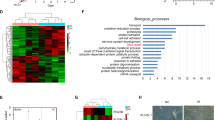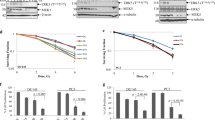Abstract
An elevated DNA-repair capacity in cancer cells leads to radiation resistance and severely limits the efficacy of radiation therapy. Activation of Akt is tightly associated with resistance to radiotherapy, and Mre11 protein has important role during the repair of DNA double-strand breaks (DSBs). In this report, our results showed that inhibition of Akt activity impaired the repair of DSBs in CNE2 cells, whereas activated Akt promoted the repair of DSBs in HeLa cells. Knockdown of Mre11 also impaired the process of DSB repair in both these two cell lines. More importantly, we found that Akt could regulate Mre11 expression. Inhibition of Akt activity by small interfering RNA or LY294002 efficiently downregulated the Mre11 expression in CNE2 cells, and transfection with myr-Akt plasmid in HeLa cells upregulated the Mre11 expression. In addition, luciferase reporter analysis revealed that Mre11 reporter activity increased after transfection with myr-Akt1 plasmids, and this myr-Akt1-induced transcriptional activity was blocked in the presence of LY294002. Further study showed GSK3β/β-catenin/LEF-1 pathway was involved in this regulation. Knockdown of β-catenin or LEF-1 led to the downregulation of Mre11, whereas overexpression of β-catenin led to upregulation of Mre11. The chromatin immunoprecipitation assay assay showed β-catenin/LEF-1 heterodimer could directly bind to the promoter of Mre11 in vivo. And the luciferase activity of the pGL3-Mre11 and pGL3-Lef increased in HeLa cells following β-catenin plasmid co-transfected, but was abolished when the LEF-1-binding conserved sequences of Mre11 promoter were mutated. These results together support Akt can upregulate the expression of Mre11 through GSK3β/ β-catenin/LEF pathway to elevate DSB-repair capacity in cancer cells.
This is a preview of subscription content, access via your institution
Access options
Subscribe to this journal
Receive 50 print issues and online access
$259.00 per year
only $5.18 per issue
Buy this article
- Purchase on Springer Link
- Instant access to full article PDF
Prices may be subject to local taxes which are calculated during checkout







Similar content being viewed by others
Accession codes
References
Altomare DA, Testa JR . (2005). Perturbations of the AKT signaling pathway in human cancer. Oncogene 24: 7455–7464.
Aten JA, Stap J, Krawczyk PM, van Oven CH, Hoebe RA, Essers J et al. (2004). Dynamics of DNA double-strand breaks revealed by clustering of damaged chromosome domains. Science 303: 92–95.
Banath JP, Olive PL . (2003). Expression of phosphorylated histone H2AX as a surrogate of cell killing by drugs that create DNA double-strand breaks. Cancer Res 63: 4347–4350.
Bao S, Wu Q, McLendon RE, Hao Y, Shi Q, Hjelmeland AB et al. (2006). Glioma stem cells promote radioresistance by preferential activation of the DNA damage response. Nature 444: 756–760.
Bellacosa A, Kumar CC, Di Cristofano A, Testa JR . (2005). Activation of AKT kinases in cancer: implications for therapeutic targeting. Adv Cancer Res 94: 29–86.
Borde V, Cobb J . (2009). Double functions for the Mre11 complex during DNA double-strand break repair and replication. Int J Biochem Cell Biol 41: 1249–1253.
Bressan DA, Baxter BK, Petrini JH . (1999). The Mre11-Rad50-Xrs2 protein complex facilitates homologous recombination-based double-strand break repair in Saccharomyces cerevisiae. Mol Cell Biol 19: 7681–7687.
Brognard J, Clark AS, Ni Y, Dennis PA . (2001). Akt/protein kinase B is constitutively active in non-small cell lung cancer cells and promotes cellular survival and resistance to chemotherapy and radiation. Cancer Res 61: 3986–3997.
Celeste A, Petersen S, Romanienko PJ, Fernandez-Capetillo O, Chen HT, Sedelnikova OA et al. (2002). Genomic instability in mice lacking histone H2AX. Science 296: 922–927.
Costanzo V, Robertson K, Bibikova M, Kim E, Grieco D, Gottesman M et al. (2001). Mre11 protein complex prevents double-strand break accumulation during chromosomal DNA replication. Mol Cell 8: 137–147.
Cross DA, Alessi DR, Cohen P, Andjelkovich M, Hemmings BA . (1995). Inhibition of glycogen synthase kinase-3 by insulin mediated by protein kinase B. Nature 378: 785–789.
Deng R, Li W, Guan Z, Zhou JM, Wang Y, Mei YP et al. (2006). Acetylcholinesterase expression mediated by c-Jun-NH2-terminal kinase pathway during anticancer drug-induced apoptosis. Oncogene 25: 7070–7077.
Deng R, Tang J, Xia LP, Li DD, Zhou WJ, Wang LL et al. (2009a). ExcisaninA, a diterpenoid compound purified from Isodon MacrocalyxinD, induces tumor cells apoptosis and suppresses tumor growth through inhibition of PKB/AKT kinase activity and blockade of its signal pathway. Mol Cancer Ther 8: 873–882.
Deng Y, Guo X, Ferguson DO, Chang S . (2009). Multiple roles for MRE11 at uncapped telomeres. Nature 460: 914–918.
Diehl JA, Cheng M, Roussel MF, Sherr CJ . (1998). Glycogen synthase kinase-3beta regulates cyclin D1 proteolysis and subcellular localization. Genes Dev 12: 3499–3511.
Ding J, Miao ZH, Meng LH, Geng MY . (2006). Emerging cancer therapeutic opportunities target DNA-repair systems. Trends Pharmacol Sci 27: 338–344.
Gupta AK, McKenna WG, Weber CN, Feldman MD, Goldsmith JD, Mick R et al. (2002). Local recurrence in head and neck cancer: relationship to radiation resistance and signal transduction. Clin Cancer Res 8: 885–892.
Haber JE . (1998). The many interfaces of Mre11. Cell 95: 583–586.
Hadjihannas MV, Bruckner M, Jerchow B, Birchmeier W, Dietmaier W, Behrens J . (2006). Aberrant Wnt/beta-catenin signaling can induce chromosomal instability in colon cancer. Proc Natl Acad Sci USA 103: 10747–10752.
He X, Zhong H . (2007). Advances in structure and function of MRN complex. Lett Biotechnol 18: 978–980.
Irie HY, Pearline RV, Grueneberg D, Hsia M, Ravichandran P, Kothari N et al. (2005). Distinct roles of Akt1 and Akt2 in regulating cell migration and epithelial-mesenchymal transition. J Cell Biol 171: 1023–1034.
Kao GD, Jiang Z, Fernandes AM, Gupta AK, Maity A . (2007). Inhibition of phosphatidylinositol-3-OH kinase/Akt signaling impairs DNA repair in glioblastoma cells following ionizing radiation. J Biol Chem 282: 21206–21212.
Khanna KK, Jackson SP . (2001). DNA double-strand breaks: signaling, repair and the cancer connection. Nat Genet 27: 247–254.
Kim IA, Bae SS, Fernandes A, Wu J, Muschel RJ, McKenna WG et al. (2005). Selective inhibition of Ras, phosphoinositide 3 kinase, and Akt isoforms increases the radiosensitivity of human carcinoma cell lines. Cancer Res 65: 7902–7910.
Kim TJ, Lee JW, Song SY, Choi JJ, Choi CH, Kim BG et al. (2006). Increased expression of pAKT is associated with radiation resistance in cervical cancer. Br J Cancer 94: 1678–1682.
Lee CM, Fuhrman CB, Planelles V, Peltier MR, Gaffney DK, Soisson AP et al. (2006). Phosphatidylinositol 3-kinase inhibition by LY294002 radiosensitizes human cervical cancer cell lines. Clin Cancer Res 12: 250–256.
Li B, Yuan M, Kim IA, Chang CM, Bernhard EJ, Shu HK . (2004). Mutant epidermal growth factor receptor displays increased signaling through the phosphatidylinositol-3 kinase/AKT pathway and promotes radioresistance in cells of astrocytic origin. Oncogene 23: 4594–4602.
Morin PJ, Sparks AB, Korinek V, Barker N, Clevers H, Vogelstein B et al. (1997). Activation of beta-catenin-Tcf signaling in colon cancer by mutations in beta-catenin or APC. Science 275: 1787–1790.
Nelms BE, Maser RS, MacKay JF, Lagally MG, Petrini JH . (1998). In situ visualization of DNA double-strand break repair in human fibroblasts. Science 280: 590–592.
Paull TT, Gellert M . (1998). The 3′ to 5′ exonuclease activity of Mre 11 facilitates repair of DNA double-strand breaks. Mol Cell 1: 969–979.
Pichierri P, Rosselli F . (2004). The DNA crosslink-induced S-phase checkpoint depends on ATR-CHK1 and ATR-NBS1-FANCD2 pathways. EMBO J 23: 1178–1187.
Pitts SA, Kullar HS, Stankovic T, Stewart GS, Last JI, Bedenham T et al. (2001). hMRE11: genomic structure and a null mutation identified in a transcript protected from nonsense-mediated mRNA decay. Hum Mol Genet 10: 1155–1162.
Shtutman M, Zhurinsky J, Simcha I, Albanese C, D'Amico M, Pestell R et al. (1999). The cyclin D1 gene is a target of the beta-catenin/ LEF-1 pathway. Proc Natl Acad Sci USA 96: 5522–5527.
Stewart GS, Maser RS, Stankovic T, Bressan DA, Kaplan MI, Jaspers NG et al. (1999). The DNA double-strand break repair gene hMRE11 is mutated in individuals with an ataxia-telangiectasia-like disorder. Cell 99: 577–587.
Takahashi-Yanaga F, Sasaguri T . (2007). The Wnt/beta-catenin signaling pathway as a target in drug discovery. J Pharmacol Sci 104: 293–302.
Takemura H, Rao VA, Sordet O, Furuta T, Miao ZH, Meng L et al. (2006). Defective Mre11-dependent activation of Chk2 by ataxia telangiectasia mutated in colorectal carcinoma cells in response to replication-dependent DNA double strand breaks. J Biol Chem 281: 30814–30823.
Taneja N, Davis M, Choy JS, Beckett MA, Singh R, Kron SJ et al. (2004). Histone H2AX phosphorylation as a predictor of radiosensitivity and target for radiotherapy. J Biol Chem 279: 2273–2280.
Toulany M, Kehlbach R, Florczak U, Sak A, Wang S, Chen J et al. (2008). Targeting of AKT1 enhances radiation toxicity of human tumor cells by inhibiting DNA-PKcs-dependent DNA double-strand break repair. Mol Cancer Ther 7: 1772–1781.
Tran H, Brunet A, Grenier JM, Datta SR, Fornace Jr AJ, DiStefano PS et al. (2002). DNA repair pathway stimulated by the forkhead transcription factor FOXO3a through the Gadd45 protein. Science 296: 530–534.
Williams RS, Moncalian G, Williams JS, Yamada Y, Limbo O, Shin DS et al. (2008). Mre11 dimers coordinate DNA end bridging and nuclease processing in double-strand-break repair. Cell 135: 97–109.
Williams RS, Williams JS, Tainer JA . (2007). Mre11-Rad50-Nbs1 is a keystone complex connecting DNA repair machinery, double-strand break signaling, and the chromatin template. Biochem Cell Biol 85: 509–520.
Wu Y, Xiao S, Zhu XD . (2007). MRE11-RAD50-NBS1 and ATM function as co-mediators of TRF1 in telomere length control. Nat Struct Mol Biol 14: 832–840.
Acknowledgements
We thank Professor Bert Vogelstein from the Howard Hughes Medical Institute Research Laboratory Sidney Kimmel Comprehensive Cancer Center for providing us with the β-catenin plasmid (wild type). This work was supported by grants from Major science and technology project of ‘National Significant New Drug Creation’ (2008ZX09312-002), 863 program (2006AA02A404), the National Nature Science Foundation of China (81001446), and Medical Scientific Research Foundation of Guangdong province (B2008059).
Author information
Authors and Affiliations
Corresponding author
Ethics declarations
Competing interests
The authors declare no conflicts of interest.
Additional information
Supplementary Information accompanies the paper on the Oncogene website
Rights and permissions
About this article
Cite this article
Deng, R., Tang, J., Ma, JG. et al. PKB/Akt promotes DSB repair in cancer cells through upregulating Mre11 expression following ionizing radiation. Oncogene 30, 944–955 (2011). https://doi.org/10.1038/onc.2010.467
Received:
Revised:
Accepted:
Published:
Issue Date:
DOI: https://doi.org/10.1038/onc.2010.467
Keywords
This article is cited by
-
The feedback loop of ANKHD1/lncRNA MALAT1/YAP1 strengthens the radioresistance of CRC by activating YAP1/AKT signaling
Cell Death & Disease (2022)
-
Targeting of AKT-Signaling Pathway Potentiates the Anti-cancer Efficacy of Doxorubicin in A673 Ewing Sarcoma Cell Line
BioNanoScience (2021)
-
3D culture conditions support Kaposi’s sarcoma herpesvirus (KSHV) maintenance and viral spread in endothelial cells
Journal of Molecular Medicine (2021)
-
Crosstalk between signaling pathways and DNA damage response
Genome Instability & Disease (2020)
-
High expression of MRE11 correlates with poor prognosis in gastric carcinoma
Diagnostic Pathology (2019)



